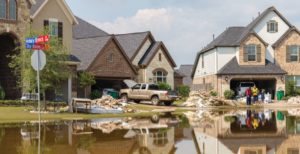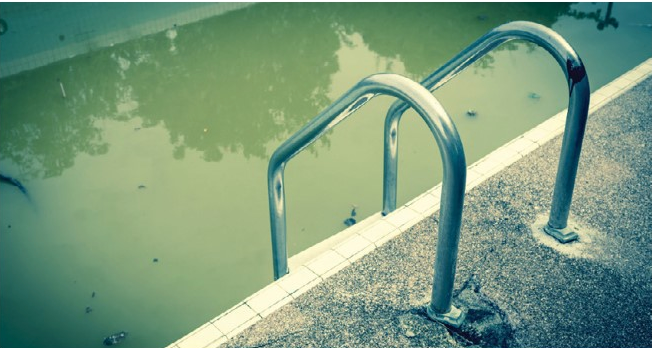
Treating flooded pools and spas
 Parts of the U.S. saw significant flooding this spring and summer, which has important ramifications for pool and spa owners who must assume floodwaters have contaminated their pools and spas with chemicals, fertilizers, oils, gasoline, sewage, germs (bacteria, parasites, fungi, and viruses), silt and debris. This contamination persists long after the floodwaters have receded.
Parts of the U.S. saw significant flooding this spring and summer, which has important ramifications for pool and spa owners who must assume floodwaters have contaminated their pools and spas with chemicals, fertilizers, oils, gasoline, sewage, germs (bacteria, parasites, fungi, and viruses), silt and debris. This contamination persists long after the floodwaters have receded.
In addition, flooding leaves behind water-damaged electrical equipment in homes, swimming pools and other outdoor living spaces. After the storm, the primary concern is always for the safety of those affected. Always exercise special care to protect yourself, your family (including pets) and other people during the clean-up and recovery period.
Precautions
Electrical safety
Electrocution is a real and present danger and accounts for many deaths after a major storm. Prior to beginning any clean-up efforts, make certain the power to all pool and spa equipment, heaters, outdoor lighting fixtures, outlets and appliances is turned off at the main circuit breaker or fuse box. Do not touch a circuit breaker or fuse with wet hands or while standing on a wet surface or in standing water. Reset breakers using a dry plastic- or rubber-insulated tool using only a single hand. If the main circuit breaker or fuse box is inaccessible or damaged, or you have any questions, immediately contact a licensed electrician to repair the damage prior to beginning any clean-up activities.
Personal safety
Do not swim or use the pool or spa. Contaminated water will contain sewage, hazardous chemicals and/or disease-causing germs. Additionally, the pool water may become murky with algae, other microbial growth and miscellaneous particulate contaminants, making the pool water turbid and dangerous.
Check the pool for wildlife. When the floodwaters recede, it’s common to find snakes and other types of wildlife in pools and other standing bodies of water. In the Southeastern U.S., alligators displaced by the floodwaters often take up residence in backyard swimming pools. If dangerous wildlife is present, immediately contact your local animal control or wildlife management department.
Chemical safety
Pool chemicals in storage areas compromised by floods pose a danger and should be disposed of properly. If chemicals were moistened, contaminated or mixed in an uncontrolled manner during or after a flooding event, violent reactions (explosions, fire and/or release of toxic fumes) may occur. Contact your local fire department or CHEMTREC at 1-800-424-9300. Be prepared to provide the names and amounts of chemicals involved. Never touch any compromised containers of chemicals without wearing gloves, eye goggles and other appropriate personal protective equipment (PPE).
General procedure after a flood
Delayed repair of flooded swimming pool or spa
If you are unable to immediately begin the repair of a swimming pool or spa, you should treat the vessel as if it is abandoned. Untreated and unfiltered pool and spa water can pose health risks from injuries, illnesses, wildlife and insects such as mosquitos. At a minimum, the following steps are recommended:
- Drowning is a real danger. Use a temporary safety fence or other approved barrier to block entry to the pool area. This prevents small children from wandering into the pool area. Additionally, as there will likely be trip hazards around the pool area from fallen trees and other debris, installing a safety fence around the pool area may prevent someone from unintentionally falling into the pool. Check with your county or local municipality for existing laws and regulations regarding minimum standards for barrier construction. Pool covers are not universally accepted as effective barriers. Generally, bolted or otherwise secured ASTM F1346-91 compliant covers are recommended to prevent additional debris from entering the pool. Loose covers (such as floating or solar covers) or damaged covers are not recommended as they tend to collapse, retain water and create a drowning hazard.
- Take measures to prevent insects from breeding in the swimming pool or spa water. Water that is not being actively treated with sanitizer can serve as an ideal habitat for disease-carrying mosquitos. Serious diseases such as West Nile virus, Zika virus, dengue fever and chikungunya, can be transmitted through infected mosquitos. Adding a larvicide or pesticide to the water may help reduce or prevent mosquito infestation. When using a larvicide or pesticide, always carefully follow the label instructions or secure the services of a licensed pesticide professional.
Many jurisdictions require by law that pools with no covering, or insufficient covering, that are not being disinfected and filtered be drained and filled with clean dirt or treated with a larvicide or stocked with native fish species approved by the state or local municipality. Check with your local officials to determine specific requirements.
Repairing a flooded swimming pool or spa
During the clean-up process, protect yourself and your family by following these steps:
- Wear appropriate PPE: slip-resistant rubber boots, chemically resistant rubber gloves and safety glasses with side shields at a minimum.
- Wash hands thoroughly with soap and warm water before eating or drinking. Use water that has been boiled for at least one minute and allowed to cool. Alternatively, water disinfected for personal hygiene use may be used. (For hand washing, add 1/8 to 1/4 teaspoon household bleach per gallon of water and allow to stand for 30 minutes before using. If treated water is still cloudy after 30 minutes, repeat treatment with household bleach and allow to stand until clear). Hand sanitizers are not effective when hands are visibly dirty. The Centers for Disease Control and Prevention has more information on food and water safety after a storm. Learn more at: https://aqmag.co/CDCfloods
- Wash contaminated clothing in hot water, detergent and bleach. Clean PPE before reuse.
Hard surface clean-up
Thoroughly clean and sanitize all hard surfaces that were in contact with floodwater. Pool decking, concrete, coping, pool ladders and railings, pool equipment and other hard surfaces should first be cleaned using hot water and laundry or dish detergent. After cleaning, sanitize hard surfaces using a solution of chlorine bleach (see table below). WARNING: Never mix chlorine products with ammonia. Chlorine gas could result. Make new bleach solutions daily as they weaken over time.
Recipe to produce a 500 ppm solution of bleach for disinfecting flood-contaminated surfaces:
| Bleach type (concentration) | Amount of bleach | Amount of water |
| Low splash (3.5% sodium hypochlorite) | 1/4 cup | 1 gallon |
| Standard (6.0% sodium hypochlorite) | 7 teaspoons | 1 gallon |
| Concentrated (8.25% sodium hypochlorite) | 5 teaspoons | 1 gallon |
Electrical components
Floodwaters and their contaminants can create serious fire hazards for previously submerged electrical wires and equipment. These hazards persist after the wires and equipment have dried out. Even with professional cleaning and drying, sediments and damaging chemicals are difficult to remove and often remain. Corrosion and damage to insulation can occur when water, chemicals and sediments get inside electrical devices and components. Floodwaters and their chemical contaminants can also damage the motors of pool and spa pumps.
CAUTION: Remediating electrical equipment is not a do-it-yourself project. Secure the services of a professional licensed by your state or local municipality to perform electrical repair work. Pool owners should be prepared to have electric components replaced. These components could include circuit breakers, circuit boards, wiring harnesses, electrical switches, valve motors, pump and blower motors, relays, wiring, sheathed cable and electronic control equipment. All replacement of electrical components should only be recommended and performed by a licensed professional.
During the clean-up process:
- Do not use a plug or switch or turn on an appliance until an electrician indicates that it is safe to do so.
- Do not use indoor extension cords outdoors.
- Never remove or bypass the ground pin of a three-prong plug.
- Do not allow outdoor power cord connections to become wet.
- Use portable ground-fault circuit-interrupter (GFCI) devices whenever possible to help prevent electric shocks and electrocutions.
- Do not use wet-dry vacuum cleaners or electric pressure washers that have been submerged, as damaged electrical parts can pose an electric shock hazard or can overheat and cause a fire.
- If using a portable generator, follow manufacturer use instructions.
Remediating the pool and spa water
As flooding and other environmental conditions vary considerably, there is no one procedure that can be universally applied to every pool or spa under all circumstances. If in doubt, secure the services of a pool/spa service professional before remediating or replacing pool or spa water. In general, the following steps should be performed:
-
- Visually inspect pool/spa and assess damage. Remove debris from the pool/spa and make sure the main drain covers are attached, intact and satisfy applicable pool safety requirements. If unable to visually inspect the main drain cover due to the presence of colored or turbid water, postpone inspection of the drain cover until clearly visible while standing on the pool deck. If damage exists to the pool surface, shell, bonding wires, decking or other pool or spa component, immediately consult a pool service professional.
- Following a catastrophic flooding event (such as hurricane rainfall or storm surge), it is not practical or cost effective to determine the types and/or amounts of toxic contaminants in the water. Therefore, the recommendation is to drain the pool water, purge all plumbing lines and replace filter media.
WARNING: When draining an inground pool, be aware that high groundwater can cause the pool to “pop” out of the ground, resulting in severe structural damage. Make sure that a hydrostatic release valve is installed and functioning properly. If you are uncertain of the ground water level in your area, do not drain the pool. To determine if ground water will be a concern, contact a pool/spa professional who can assist you to determine the best course of action. Additionally, check with local water and sewer authorities to determine proper disposal requirements for the contaminated pool water. While draining the pool water, repeatedly brush and rinse to clean the sides of the pool. - Once drained, remove debris, organic matter and silt. In some cases, power washing may be required to clean the pool or spa surface. Use a surface cleaner designed for recreational water to remove any stains or discolorations. Typical surface cleaners include 10% muriatic acid (prepared by slowly adding one part muriatic acid to ten parts of water) or liquid bleach (see table above).
WARNING: NEVER MIX CHLORINE AND ACID SOLUTIONS TOGETHER! Rinse surfaces thoroughly and remove any rinse water from the pool. If performing both an acid and chlorine wash, always acid wash first before a chlorine wash. Rinse thoroughly between the two washes. - Make sure all filtration equipment is in proper working order.
- Add fresh potable water to the pool. Do not fill the pool with untreated well water as it is likely to be contaminated. If necessary, truck in water from a reliable source. Balance and sanitize the pool water making sure the chemical parameters are within industry standards (See ANSI/APSP/ICC-11). Once pool chemical parameters remain within recommended ranges and sanitizer residuals are maintained, normal use of the pool/spa can resume.
This article originally appeared in the August 2019 issue of AQUA Magazine and is reprinted with permission.








